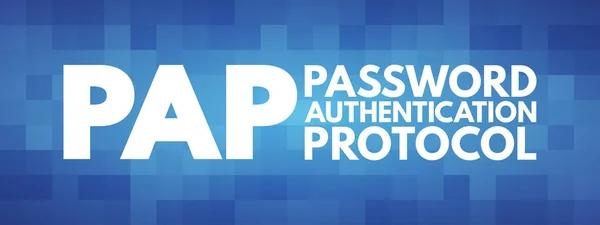What is Password Authentication Protocol?
The Password Authentication Protocol (PAP) is a commonly known authentication method used alongside the Point-to-Point Protocol (PPP). It offers a straightforward way for users to verify their identity with a network access server using a username and password. This protocol is essential for validating user identities and granting access to network resources, especially in remote access service scenarios.

ad
How Password Authentication Protocol (PAP) Operates
The operation of PAP is simple and effective in environments where high security is not a primary concern. The authentication process typically unfolds as follows:
- The user starts a session to connect with a network server.
- The server requests the user’s credentials (username and password).
- The user sends these credentials, which are transmitted in plain text.
- The server checks the credentials against its authentication database. If they match, the user is authenticated and granted network access.
It’s important to note that the simplicity of PAP, involving the transmission of unencrypted credentials, makes it vulnerable to certain cyber threats.
ad
Examining the Vulnerabilities
The most critical security flaw of PAP is its transmission of usernames and passwords in plain text over the network. This makes the credentials susceptible to interception by malicious entities using methods like packet sniffing. Once intercepted, these exposed credentials can be exploited by attackers to gain unauthorized network access, posing significant risks to data confidentiality and integrity.
Strategies for Mitigating Security Risks
Despite its vulnerabilities, the risks associated with using PAP can be mitigated through several security practices:
- Transition to More Secure Protocols: Switching to advanced authentication protocols like CHAP (Challenge-Handshake Authentication Protocol) or EAP (Extensible Authentication Protocol) enhances security by ensuring that passwords are not transmitted in clear text.
- VPN Encryption: Using Virtual Private Networks (VPNs) with strong encryption standards protects data in transit, including authentication credentials, thereby reducing the risk of interception.
- Two-Factor Authentication: Adding an extra layer of security with two-factor authentication (2FA) significantly improves defenses by requiring a second form of verification beyond just the password.
Weaknesses of the password authentication protocol
- Lack of encryption: PAP transmits data in plain text, making it vulnerable to eavesdropping and interception.
- No protection against replay attacks: Without incorporating a timestamp or session identifier in the authentication request, the message can be captured and replayed later.
- Susceptibility to man-in-the-middle attacks: PAP authentication functions unidirectionally, leaving data exposed to MITM attacks.
Password authentication protocol alternatives
- Challenge Handshake Authentication Protocol (CHAP): CHAP is an authentication protocol known for its security, employing a three-way handshake process. It initiates by sending a random challenge string to the user, who then encrypts and returns it to the server for verification. This iterative process enhances security during authentication.
- Extensible Authentication Protocol (EAP): EAP is a versatile authentication protocol accommodating various authentication methods, such as digital certificates, smart cards, and biometric authentication.
- Lightweight Extensible Authentication Protocol (LEAP): LEAP, a proprietary authentication protocol developed by Cisco, employs a two-way handshake process. It supports mutual authentication to counter spoofing attacks, enhancing security.
Difference between PAP & CHAP
PAP follows a two-way handshake process, where the client sends credentials to the server for verification, leading to user authentication. Conversely, CHAP employs a three-way handshake process, introducing an extra security layer by avoiding password transmission over the network, thus protecting credentials from potential threats.
CHAP was developed to address security vulnerabilities inherent in PAP’s point-to-point authentication method. Unlike PAP, CHAP doesn’t transmit passwords; instead, it uses cryptographic techniques, like encrypted hashes, with both server and client sharing a secret key.
Moreover, CHAP can conduct repeated authentications mid-session, thwarting potential interception of PPP connections when a port remains open after a remote device disconnects. These security enhancements in CHAP significantly bolster PPP sessions compared to PAP.
FAQ’s
What is Password Authentication Protocol (PAP), and how does it work?
PAP is an authentication method used alongside the Point-to-Point Protocol (PPP). It allows users to verify their identity with a network access server using a username and password. The process involves the user initiating a session, providing credentials (username and password), and the server verifying these credentials against its authentication database.
Why is PAP considered vulnerable to cyber threats?
PAP transmits credentials in plain text over the network, making them susceptible to interception by malicious entities like packet sniffers. This vulnerability exposes user credentials to potential exploitation, posing risks to data confidentiality and integrity.
How can the security risks associated with PAP be mitigated?
Security risks with PAP can be reduced by transitioning to more secure protocols like CHAP or EAP, which do not transmit passwords in clear text. Additionally, using VPN encryption and implementing two-factor authentication (2FA) can bolster security by safeguarding data in transit and adding an extra layer of verification beyond passwords.
What are some weaknesses of the Password Authentication Protocol?
PAP’s weaknesses include the lack of encryption, leaving data vulnerable to eavesdropping and interception. It also lacks protection against replay attacks and is susceptible to man-in-the-middle attacks due to its unidirectional authentication process.
Conclusion
While Password Authentication Protocol (PAP) offers simplicity in user authentication, its reliance on transmitting credentials in plain text exposes significant security vulnerabilities. Transitioning to more secure protocols like CHAP or EAP, along with implementing VPN encryption and additional security measures like two-factor authentication, is crucial to mitigate these risks. By prioritizing security, organizations can better protect their networks and sensitive data from potential cyber threats.
ad


Comments are closed.